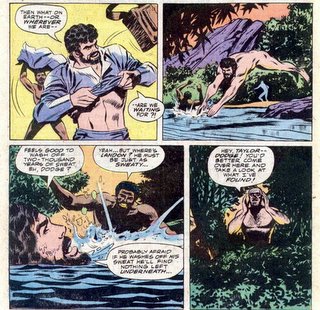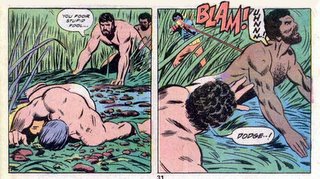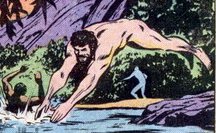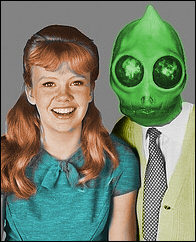On occasion I take a swipe at the aspects of what I consider to to be the unecessary sexuality in comic books that have all the appearence of a cheap marketing ploy to get fan dollars. I'm all for nudity, don't get that wrong, I just have a thing about cynical scams that manipulate (Extreme Bread? What the hell?). You can pick up almost any comic of the 90's for a desperate-industry-out-of-control example of that. One of the best examinations of the use of cheap titillation to secure readers was uncovered and closely examined in the Boob War entries at Dave's Long Box.
To make my point of the typical marketing scam the image I refer to most often is the cover of New X-Men #116, featuring the infamous White Queen front-seam art by Frank Quitely. On the flip-side, the new Bulleteer has imagery that I can grudgingly agree is actually a part of the story of the seamy side of hero obsession.
So while all this pushing-the-envelopes goes unnoticed or accepted in comics there are also examples where the self-editing censorship stamp gets applied inappropriately in relation to the story. It should come as no surprise to anyone who has ever read a comic that the industry practices a double standard when it comes to that form of censorship.
In 1974 Marvel published a tie-in to the popular Planet of the Apes films. Adapted by Doug Moench, drawn by George Tuska, inked by Mike Esposito and colored by George Russos, the first several issues covered the first of the Ape films. In the adaptation, a rocket crew is stranded on what they think is an alien planet and they wander a desert, slowly dying of thirst. Eventually they stumble across an oasis and like all healthy red-blooded astronauts suffering from dehydration, immediately get naked and go skinny-dipping with each other. While engaged in their SF-themed homoerotic play the crew witnesses and is then assaulted by intelligent apes out on a raid to collect slaves. It was during the chase scenes that I had my first exposure to comic book censorship. While I am sure that there are other examples of it in books that I missed this was the first that I actually noticed, having grown as a reader and collector. By that time I looked at comics with a more critical eye. Even as a young Sleestak I knew that what Marvel did with the art in the issue was just plain wrong and innapropriate given the setting.
While engaged in their SF-themed homoerotic play the crew witnesses and is then assaulted by intelligent apes out on a raid to collect slaves. It was during the chase scenes that I had my first exposure to comic book censorship. While I am sure that there are other examples of it in books that I missed this was the first that I actually noticed, having grown as a reader and collector. By that time I looked at comics with a more critical eye. Even as a young Sleestak I knew that what Marvel did with the art in the issue was just plain wrong and innapropriate given the setting.
What caught my attention was the pages where the crew is unsuccessfully fleeing the apes. Someone had clumsily re-touched the nude astronauts so that it appeared they were wearing colored underwear. No one at Marvel even bothered to draw in seams or anything beyond a few changes in color. Now I didn't particularly want to see naked astronaut ass in a comic book, but unlike some scenes where the nudity is of a faux or explicit nature (and 99% of the time involve females), the astronauts leaping naked from the pond and running makes sense in the context of the story. While the artists were careful in their layouts not to show the crews' space-wangs flipping about some scenes that obviously caused someone to worry about the content were unavoidable, such as running across an open field .
Now I didn't particularly want to see naked astronaut ass in a comic book, but unlike some scenes where the nudity is of a faux or explicit nature (and 99% of the time involve females), the astronauts leaping naked from the pond and running makes sense in the context of the story. While the artists were careful in their layouts not to show the crews' space-wangs flipping about some scenes that obviously caused someone to worry about the content were unavoidable, such as running across an open field . If I was for some reason swimming naked and a guy on horseback started shooting at me, I would not pause to put on some clothes. I would run like hell. Nor would I, as it seems the astronauts did, pause to trade their undies for a good fit and color match.
If I was for some reason swimming naked and a guy on horseback started shooting at me, I would not pause to put on some clothes. I would run like hell. Nor would I, as it seems the astronauts did, pause to trade their undies for a good fit and color match. It's ridiculous that given the scene that someone panicked and censored the book in such a lame way, considering that just a page before Bright Eyes was portrayed in all his space-glory with not a hue out of place.
It's ridiculous that given the scene that someone panicked and censored the book in such a lame way, considering that just a page before Bright Eyes was portrayed in all his space-glory with not a hue out of place. You can't lay the blame for the puritanical touch-up job on colorist George Russos. If he did make the changes, then it was obviously under editorial direction. I have heard stories where the printers back then would take it upon themselves to color-correct some characters (which caused reader-confusion every now and then) but that seems a little unlikely in this case because it was not an issue in an earlier panel. The above panel actually shows more well-sculpted flank than the other panels, which are for the most part are drawn as wide scenes and not as close ups.
You can't lay the blame for the puritanical touch-up job on colorist George Russos. If he did make the changes, then it was obviously under editorial direction. I have heard stories where the printers back then would take it upon themselves to color-correct some characters (which caused reader-confusion every now and then) but that seems a little unlikely in this case because it was not an issue in an earlier panel. The above panel actually shows more well-sculpted flank than the other panels, which are for the most part are drawn as wide scenes and not as close ups.
This is just a clear example of the double-standard that exists in the popular media concerning nudity. The message was that it's okay for women to be sleazified and objectified but not men. It is implicit that on a monthly basis it's acceptable to shove in our faces a female's Grand Canyon-esque cleavage, swollen areolas, nipples and in some cases the well-detailed and outlined vagina, but you can't show a man's exposed, non-threatening buttocks.
Now you say to yourself "That was 1974. Comics, readers and society has changed since then. What's that got to do with the industry and censorship in 2006?".
As an answer to that I present a recent and perfect example as exhibit #1 of the comics double-standard of nudity and censorship that remains unchanged from 1974.
You've come a long way, baby.




























Excellent post. I don't mind the semi-nudity, tho I do agree at times, they go too far. But I do hate the double standard.
ReplyDeleteAnd if anyone thinks we're fooled by some odd coloring to simulate swim trunks or briefs, then I'd like to have a few choice words with them.
Unfortunately, this attitude isn't just in comics.
I suspect the old Planet of the Apes. stuff was done at the behest of the Comics Code Authority.
ReplyDeleteWell, yeah. but again, it wasn't a problem in the other panel.
ReplyDeleteI'm just glad the butt-shot phenomenon is getting so much attention these days.
ReplyDeleteI'm just glad somebody used the phrase "space wang."
ReplyDelete"Fragile...sexual...self-image...disintegrating at sight of male buttocks! Must...interpose...clumsy illusion of underwear!"
ReplyDelete"Whew, that was a close 'un. Homosexuality narrowly averted! I guess the kiddies will be safe too...except the color-blind ones. Oh well, can't save 'em all. The world needs its fashion designers. And they don't need to discern colors anyway."
Do you think that the nudity in the planet of the apes comic is a strong element in symbolizing that the humans are now animals since they are naked, and the apes are wearing clothes? Granted there acts of swimming together and so forth may be a stretch in the premise, but as a storytelling device the nudity seems to make sense to me and think it might be a bad example to make the point you are making.
ReplyDelete